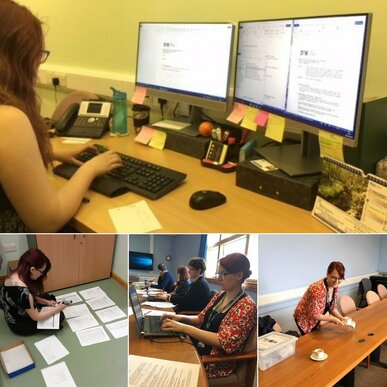|
Natasha Stacey, who is the Administration Assistant for DYW Orkney, is currently undertaking her Modern Apprenticeship in Business and Administration. She is recording her journey in this blog series. In the fourth instalment she explains how she is assessed in her role.  Natasha is pictured preparing for a board meeting, taking minutes and tidying up afterwards. Natasha is pictured preparing for a board meeting, taking minutes and tidying up afterwards. I have now been doing my SVQ Level 2 Business and Administration course for four months and I am doing really well. I have submitted online to my assessor 31 times now and have completed two of my eight units which has got my final sign off percentage to 83% and my evidence coverage percentage to 92%. I have evidenced this work through a range of storyboards, knowledge reports, witness testimonies and observations. As part of my role as DYW Admin Assistant, I take minutes at DYW Orkney Regional Group Board meetings so I chose the ‘Taking Minutes’ unit as part of my SVQ. I had previously written a reflective storyboard about minute taking, but I was finding it difficult to write another without repeating myself. I spoke to Laura, one of my assessors, to get advice on how I could evidence taking minutes in a different way and she said that she would be happy to come to the next meeting and do an observation. An observation is when your assessor physically watches you doing part of your job which evidences that you are competent in your role. Your assessor records what they see and they break down the tasks you are doing and record exactly what they have seen. The best observations record both performance and knowledge points across more than one unit. Prior to the observation, my other assessor made a plan identifying which performance and knowledge points could be covered in the meeting for Laura to observe, there were nine points in total across five units. Laura and I met before the meeting so that we could talk about the observation, in this time I was able to ask any questions I had and she then observed me setting up the room and greeting members as they arrived. During the meeting Laura watched how I took minutes while taking photos for her report. After the meeting Laura and I spoke about how I wrote the minutes and at this time I got some good advice from her as she also minutes meetings. We then looked at other knowledge points that I could get and had discussions about these. I found this really helpful as some of the knowledge points can be hard to write about but easy to explain in conversation. The following day, Laura visited me in my workplace to observe me writing the minutes from the notes I had taken at the meeting and took photos as part of the evidence for her report. Once I had circulated the minutes to all board members and others present at the meeting, Laura wrote her observation report. This report had a mix of photos and detailed breakdowns of what I had done in the meeting and what we spoke about after the meeting. This report boosted my final sign off percentage and gave me good ideas of what to evidence next. Natasha StaceyI am the Administration Assistant for DYW Orkney and I am a Modern Apprentice. I am currently completing my SVQ Level 2 in Business and Administration. Comments are closed.
|
Archives
June 2024
Categories
All
|
 RSS Feed
RSS Feed